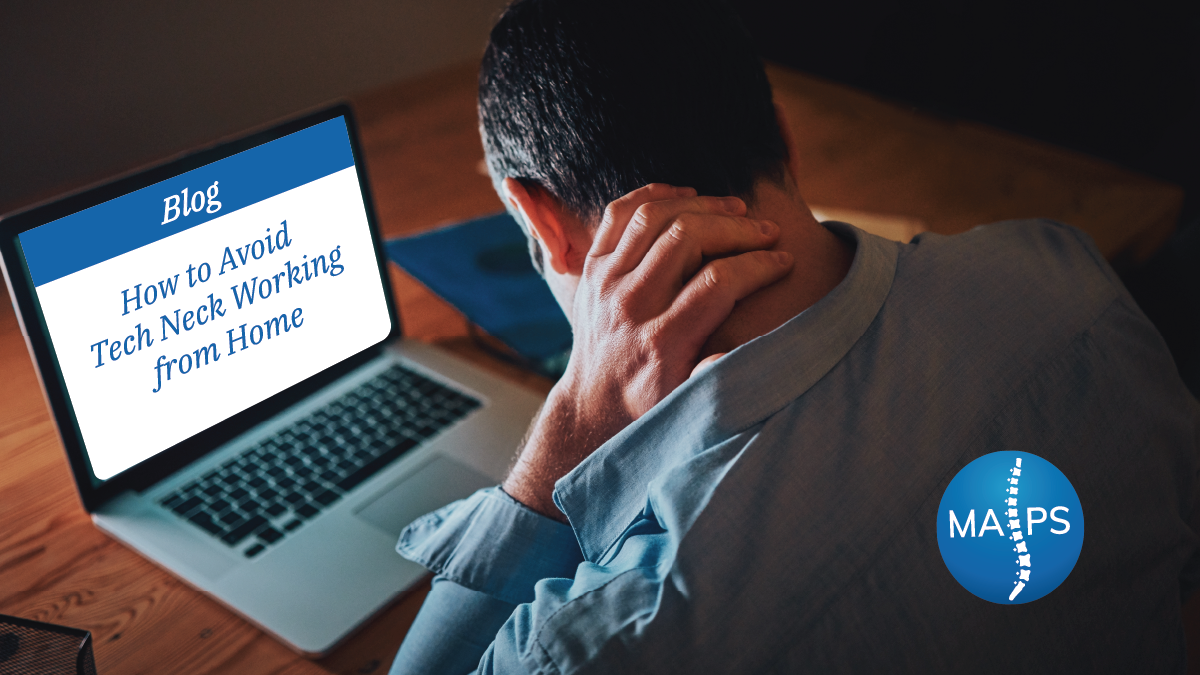How to Avoid Tech Neck Working from Home


The global challenges of the last couple years have resulted in huge changes in the workforce, including a tremendous increase in the number of people working from home. While there are advantages to remote work, more people are experiencing challenges with posture and pain because they’re working from dining room tables and kitchen chairs, which aren’t ergonomically supportive. Is the neck pain you’re experiencing “tech neck”?
The Spine and Weight Distribution
The curves of a healthy neck and back act as a spring that distribute the weight of the head and the upper body down through the spine and into the hips and legs. If any of the curves are disturbed, that distribution chain shifts and results in pressure increases. “Tech Neck” is a cluster of symptoms that in recent decades has led to degeneration and musculoskeletal pain in the neck, caused by looking down at portable devices and a flattening of the cervical curve. A downward gaze puts the full weight of the head at the back of the neck, which is roughly the equivalent of a 60lb. strain. How can you avoid this type of neck pain?
Get Up and Move
It’s easy to get drawn into the flow of work and assume the same position for a couple hours, but the inactivity of sedentary work invites a slew of physical complications. Get up at least once every 30 minutes or so to warm and stretch neck, back and shoulder muscles that support healthy posture:
- Gaze forward, then tip the right ear toward the right shoulder and hold, repeat on the left
- Gently close jaws and gaze up to hold, then lower chin to chest and hold
- Shoulder rolls front to back, then back to front
- Vigorous arm swings that cross in the front, swing front to back, and both arms side to side to create twisting and movement along the whole spine
Practice Perfect Posture
Before you’re fatigued from a long day at work, set up in front of a mirror or have a friend take a picture so you can see your typical standing and seated postures, and make adjustments to your alignment. Tech Neck often accompanies a forward-jutting position of the head and rounding of the shoulders, so simple changes like pulling the chin back toward the throat, working to align the ears over the shoulders, and drawing the shoulders back can help ease the strain. Create some muscle memory around the sensation of correct alignment, and check in a couple times an hour to make sure you’re not slumping.
Strengthen Neck and Core Muscles
Part of the problem with maintaining healthy posture is weak muscles, and tech neck is both a contributor to and result of the problem. When we gaze down at our portables, neck muscles in the front of the neck get short and weak, and those at the back of the neck get long and weak. Over time, it gets more difficult to hold our heads upright. Additionally, muscles through the torso and seat and those that wrap around the front back of the midsection, also known as the “core” muscles, are very important in keeping a tall and strong spine. Focusing on strengthening the core can ultimately support less neck pain.
Prop Your Portables
It’s not just the desktop that will compromise posture; time spent on laptops, tablets and phones can wreak havoc on cervical alignment, so lift them up to the sightline instead of dropping the gaze and head position. Adjustments like font size and screen brightness can keep you from straining forward to see your laptop work, and hugging your upper arms to your ribs can help retrain your habit of looking down instead of forward for tablets and phones.
How to Help Tech Neck
If your remote work is already contributing to the head, back, and neck pain associated with tech neck, there are options for effective relief while you rebuild supportive posture:
- Injection based therapies like trigger point, facet, and cervical epidural injections provide fast relief
- Interventional modalities like radiofrequency ablation, kyphoplasty, and disc decompression are non-surgical options long term relief
- Physical therapy helps rebuild healthy tissues and muscle tone
- Bracing may be necessary for stability in the bones and ligaments
If Tech Neck is the Problem, MAPS is the Answer
Modern maladies need modern solutions, and the double board-certified physicians at MAPS Centers for Pain Control are on the cutting edge of interventional pain management combined with compassionate, comprehensive care. Contact us today for the support and relief you deserve!

